Displaying items by tag: Pat Lyons
#royalcork – Four years and seven months may seem an eternity for many people. Yet if you're in the business of planning major club and sporting events, particularly where there's a significant international context, then four years and seven months is but the blinking of an eye. In 2020 - in four years seven months and 22 days to be precise - the Royal Cork Yacht Club will be 300 years old. W M Nixon takes a look at life in and around a very remarkable and undoubtedly unique organisation as it moves steadily towards its special date with destiny.
The world's oldest yacht club is in good health, enjoying a growing membership with an increasing and very distinguished international flavour. And it already has a proven track record in marking significant birthdays. Back in 1969-70, led by Clayton Love Jnr as a visionary and energetic Admiral, the club celebrated its Quarter Millennium with a two year sailfest which included finishing a Transatlantic Race, starting or finishing several other major offshore races, staging several national and international championships, running a race week, and co-ordinating an especially successful Cruise-in-Company by a large fleet from Cork Harbour to Glengarriff on Bantry Bay.
In this galaxy of sailing events, the Royal Cork's traditions of volunteerism and competitive involvement afloat was much in evidence. If Crosshaven sailors weren't running the show afloat and ashore, then they were likely to be competing in it afloat, and almost inevitably featuring in the frame.
So in all, those staging the Quarter Millennium set a standard which their successors planning towards 2020 - which is additionally distorted by being an Olympic year - will find difficult to match. For they'll be doing so in a very changed world in which newly re-born regattas and special events are crowding the national and international calendar, while the undoubted international change of attitude in favour of events in warmer climates means that a sailing club on an island well north in the Atlantic will have to try that much harder to attract the kind of boats and sailors its major and unprecedented anniversary merits.
But far from being fazed by the prospect of what needs to be done for 2020, the Royal Cork YC relishes living life to the full in the here and now. During the past year and more, the Crosshaven club has been led with such enthusiasm and exemplary energy afloat and ashore by Admiral Pat Lyons that at the National Sailing Awards in Dublin in March, it was announced that the Royal Cork was the winner – for the sixth time - of the annual ISA/Mitsubishi Motors "Sailing Club of the Year" trophy, which dates back to 1979 but has been firmly under the wing of Mitsubishi Motors since 1986.
However, although the announcement was made at a national gathering, the essence of the Club of Year accolade is that the winning club and its members should be honoured in their own clubhouse in its own very specific local setting. Which sounds straightforward enough. But when you get into the world of high-powered sailing types and the challenge of trying to get many fast-moving targets into one place at the one time, it makes herding cats seem like a doddle. So it wasn't until this week that a date was finally found on which most of the key players in the Royal Cork scene would be in and around their clubhouse. But it was well worth the effort and the wait – the ceremony provided us with the very purest spirit of Royal Cork.

Crosshaven in high summer. Around Cork Harbour, the interaction between sea and land seems much more comfortable than anywhere else in Ireland. Photo: Robert Bateman

At this week's Club of the Year awards ceremony for the Royal Cork YC were (left to right) W M Nixon, (chairman of the adjudicators), David O'Brien (ISA Board Member), Pat Lyons (Admiral RCYC), Frank Keane (Chairman Mitsubishi Motors), and Billy Riordan (CEO Mitsubishi Motors). Photo: Robert Bateman
Such is the enthusiasm of this remarkable club at its immaculately-maintained and hospitable clubhouse/marina complex in Crosshaven that you'd think they must be one of the newest in the land. But they went at their sailing in 2014 as though it was Tricentenary time already, running a nine-month club sailing programme with an extensive junior training input, and in addition staging the ISAF Women's International Match Racing Worlds in June.
Then in July they hosted a successful Cork Week which – apart from providing great racing for all competitors – showcased the new Irish International Commodore's Cup Team for the first time, an auspicious debut as the team went on to win the Commodore's Cup, with Royal Cork's Anthony O'Leary playing a key role throughout.
Anthony O'Leary also won the British IRC Opens and the Irish Helmsmans Championship, and then for good measure he took the 1720 Nationals as well. Meanwhile, RCYC's Harry Durkan took the junior title, while clubmate Seafra Guilfoyle was garlanded with international success in the Lasers.
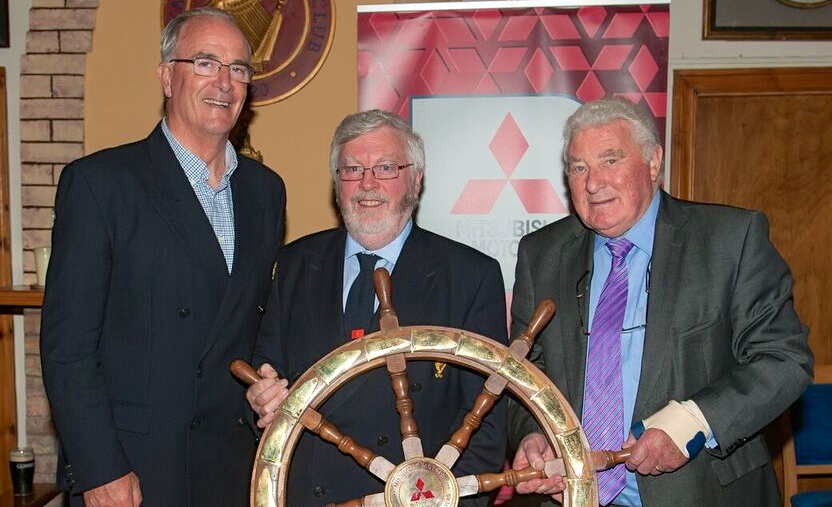
Commodore's Cup Team Captain and Afloat.ie Sailor of the Year 2014 Anthony O'Leary with RCYC Admiral Pat Lyons and Frank Keane of Mitsubishi Motors. Photo: Robert Bateman
On the cruising front, it was to be announced in due course that during 2014, the voyaging by Royal Cork YC longtime member Neil Hegarty in his 34ft sloop Shelduck on both sides of the Atlantic, and across it too, had been awarded the premier trophy of the Irish Cruising Club, the Faulkner Cup. As it happens, the skipper of Shelduck was one of the few conspicuous absentees from this week's ceremony, for the very good reason that he's already away cruising in America. But the ICC was well represented by Vice Commodore Dan Cross of Crosshaven, and also by former RCYC Admiral Paddy McGlade, who in 2014 organised the Cruising Club's very successful 85th Anniversary Cruise-in-Company from Crosshaven to Glengarriff with an exemplary lightness of touch.
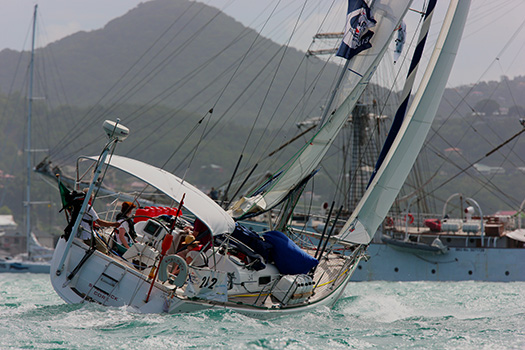
Neil Hegarty of RCYC bringing his Dufour 34 Shelduck into port at the conclusion of a Transatlantic passage during his award-wnning 2014 cruise.
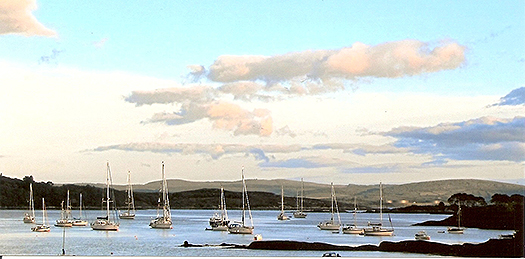
Part of the Irish Cruising Club's fleet in Glengarriff during the Cruise-in-Company organised by Royal Cork's Paddy McGlade
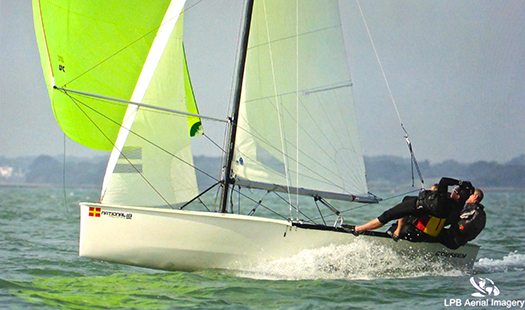
Odyssey, the prototype of the new National 18 whose development has been largely driven by the Cork Harbour division of the class.
Back home meantime, the Royal Cork's busy and long-established fleet of National 18s played the key role in developing the new National 18 which is currently being launched to popular acclaim, and two of the key figures in what amounts to a remarkable community movement – Dom Long and Tom Dwyer – were enthusing, and quite rightly too, about the new boats in the RCYC at this week's gathering.
At the height of the season, the Royal Cork was one of the clubs leading the movement in putting new life back into the established two-person dinghy classes. And looking to the future this summer, the club's plan to revive Dinghy Week as a four day event in August already shows every sign of success, emphasising the presence of an ongoing sense of the continuity of Cork Harbour sailing, something which in its turn is reinforced by a healthy and dynamic interaction with the community within which this great club is set.
There is no doubt that Cork is different. It interacts with the sea in a much more comfortable way than anywhere else in Ireland, and boats are everywhere about Cork harbour, whether nestling in a mudberth, or lying to a sheltered mooring, or berthed in one of the sparkling new marinas which seem to be springing up in every part of the harbour as the economy gets going again.
As for trying to capture the essence of the Royal Cork, the fact that the Club of the Year trophy adjudication force us to take a still from a moving film – often a very fast-moving film – only serves to emphasise how successful the RCYC is at so many levels.
Thus its exceptional successes in 2014 have now been clarified in proper order and full detail. But already they've moved well into 2015. Cork sailors were very much to the forefront in the recent major Laser event on Lough Erne, with young Nicholas Walsh the pace-setter. And of course the indefatigable Anthony O'Leary is already the Afloat.ie "Sailor of the Month" for April after his clean run of success with the new Ker 40 Antix, ex-Catapult, in the Solent.

Party time in the Royal Cork after the formal presentation ceremony. The trio at right are ICC Vice Commodore Dan Cross and Sally and Anthony O'Leary. In classic Crosshaven style, Dan and Anthony have been friends and neighbours ashore and afloat since childhood. Photo W M Nixon
He finds her a fascinating boat after his more conservative Ker 39, the silver Antix of 2006 vintage. Whereas the older boat was quite docile to steer, as she had twin wheels complete with footbrace pads for the helmsman, the new boat is more like a giant dinghy with a widow-maker of a tiller, and the helmsman having to be hyper-fit to keep himself in place on that very wide cockpit. The word from Skipper O'Leary is that the red Antix is a dream to helm to windward, but steering her on a hairy run can be....well, very hairy indeed.
That such things could be discussed with the man himself was all of a piece with the remarkable mood in the Royal Cork Yacht Club, where the conversation turned with equal ease to the new Cool Route. This is the cruising trail from southwest Ireland to northern Norway which is being developed in Cork Institute of Technology by RCYC member John McAleer with the club very much on board as an international marketing partner.
As to just how this will go, we can only think for now that if they could just somehow bottle the communal can-do spirit of the Royal Cork and then get it to work its magic in all the other prospective ports along the Cool Route, then they really would have a winner. Meanwhile, congratulations to the Royal Cork Yacht Club, ISA/Mitsubishi Motors Sailing Club of the Year for 2015.
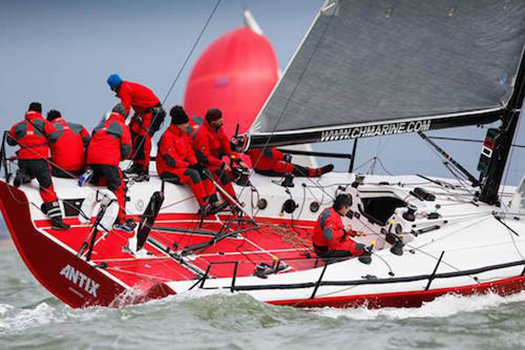
A different animal altogether. After the compact and comfortable two-wheel arrangement on the silver veteran Ker 39 Antix , the new tiller-steered Ker 40 Antix may provide a more direct feedback sailing on the wind for helmsman Anthony O'Leary, but hectic downwind sailing can become very hairy indeed.
Lyons Hopes For a Special Cork Week in 2012
#CORK WEEK - Pat Lyons of Royal Cork Yacht Club has spoken to website The Cork News about the city's hopes for the 2012 Cork Week regatta.
Crosshaven in Cork Harbour will host the club's biggest regatta - which takes place every two years - from 7-13 July this summer.
“Sailing in Ireland and Cork is in great shape,” says Lyons, who is expecting more than 250 boats to pack the harbour for racing and more.
The event is also perfectly timed just two weeks ahead of the 2012 Olympic Games in London, where Royal Cork Yacht Clubman Peter O’Leary will vie for gold with Dublin yachtsman David Burrows in their two-man keelboat.
Though the economic downturn has had a serious effect, costs have been cut across the board and some rules have been relaxed to allow for the widest possible level of participation.
“There are three factors that make Cork special," says Lyons. "Firstly, there is the number of boats and the various fleets. Secondly, there are 10 races planned. While that doesn’t always pan out due to the weather, we have pretty settled weather conditions and an excellent coastline in Cork, with hills running down to the sea.
"And finally, there is the harbour, which, if the weather impacts, provides excellent shelter. We’ve always been able to achieve a higher level of competition than a lot of other regattas, with at least one or two races per day.”
As previously reported on Afloat.ie, preparations for the event have already kicked off with the launch of a dedicated new website.
The Cork News has more on the story HERE.





























































